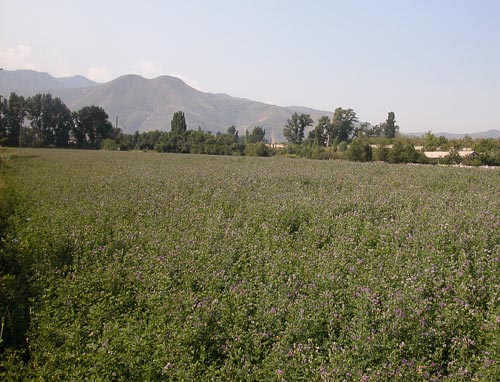Crops
Medicago varia Mart. - Sand, hybrid or variegated lucerne, changeable alfalfa, bastard medic.
Taxonomic position.
Family Leguminosae Endl., genus Medicago L., subgenus Falcago (Reichb.) Grossg.Synonyms.
Medicago sativa nothosubsp. varia (Martyn) Arcang.Medicago media Pers.
Morphology and biology.
Perennial herb with well-developed root system. Deep-rooted, 2-4 m or more in deep, well-drained soils. About 60-70% of total root mass is in the upper l5 cm of soil profile. Stems are procumbent or ascending, from 40-70 to 80-110 cm high. Leaflets are narrowly obovate, 10-25 mm in length, 5-10 mm in width. Racemes cylindrical, 1.5-5.5 cm in length, rather diffuse, with 11-23 flowers that range in color from light-violet to greenish-yellow. Pods are coiled (1-3 coils or rarely 0.5-1 coils). Blossoms June-August. Seeds ripen September-October. Cross-pollinated by several types of bee-honey, short-tongued cutter, alkali bumble bees. 2n =16, 32. The cultivated species has a hybrid origin by natural and artificial mating between Medicago sativa and Medicago falcata.Distribution.
Cultivated since the 20th century. Cultivated on large tracts of land in the forest and steppe areas of 112 regions and republics of former USSR. State permission for utilization has been given to 60 cultivars.Ecology.
Species is well-adapted to a wide range of climatic and soil conditions, but grows best on deep, loamy soils that are well drained. It is relatively drought-tolerant but also responds very well to irrigation. It tolerates some alkalinity, but does not do well on highly-alkaline or salty soils. It is not tolerant of flooding, waterlogging or poor soil drainage. It will withstand short periods of flooding if they occur before growth begins in the spring.Utilization and economic value.
Characterized by high ecological plasticity. More frost-resistant than Medicago sativa L. and so has more potential in extreme environmental conditions. Responsive to irrigation and soil fertility. Suitable for growing without irrigation in steppe and partially-wooded steppe in both hemispheres. Perenniality and upright growth habit make it a highly suitable crop for conservation as hay, silage or in dehydrated form. Usually productive for 4-6 years. Range of cultivars with differing characteristics has extended its ability to grow in environments from very dry to very cold. Generally grown in monoculture. Has a higher tolerance of saline soils than many other forage species. Rich in protein, minerals and vitamins. Feeding value largely determined by stage of growth at the time of utilization since nutritive value falls with advancing maturity and associated increase in stem: leaf ratio. Increasing the number of crops in a season by cutting at earlier stages of growth improves forage digestibility and crude protein content but at the expense of yield. In comparison with grass at similar stages of growth, species has lower cell wall and digestible fiber content but higher digestible cell and crude protein contents. It also has a higher content of most minerals of nutritional importance to livestock. Drought resistant. Valuable rotation crop in arable and organic systems because of N-fixation ability and source of organic matter. Forage mass productivity ranges from 7.5-15 MT/ha without irrigation; 50-120 MT/ha with irrigation; hay productivity ranges 1.5-7.5 MT/ha without irrigation; 10-15 MT/ha with irrigation and seed productivity is 150-300 kg/ha. It is an excellent source of nectar and pollen for honey bees. Unsuited to intensive grazing. Susceptible to many pests and diseases. May cause bloat in ruminants. Plant saponins may interact with rumen bacteria and cause haemolysis in animals.Reference citations:
Catalog of agricultural crops' cultivars permitted in Byelorussia. 1985. - Minsk: Uradjai, 176 pp. (in Russian).Catalog of state permitted cultivars of agricultural crops. 1969. - Moscow: Kolos, 489 pp. (in Russian).
Catalog of state permitted cultivars of agricultural crops. 1971. - Moscow: Kolos, 488 pp. (in Russian).
Catalog of state permitted cultivars of agricultural crops. 1974. - Moscow: Kolos, 480 pp. (in Russian).
Catalog of state permitted cultivars of agricultural crops. 1985. - Moscow: Kolos, V. 3: 489. (in Russian).
Golovkin B.N. 1988. Cultigenic plant area. Moscow: Nauka. 184 pp. (in Russian).
Kashtanov, A.N., ed. 1983. The Natural-agricultural regions and utilization of soil resources of the USSR. Moscow: Kolos. 336 pp. (in Russian).
Medvedev P.F., Smetannikova A.I. 1981. The forage crops of European part of the USSR. Leningrad: Kolos. 336 pp. (in Russian).
Shashko D.N. 1967. Agroclimatic region of the USSR. Moscow: Kolos. 335 pp. (in Russian).
Shashko D.N. 1985. Agroclimatic resources of the USSR. Moscow: Kolos. 248 pp. (in Russian).
State register of breeding achievements permitted for utilization. Plant cultivars. 1994. -Moscow: -218 pp. (in Russian).
State register of breeding achievements permitted for utilization. Plant cultivars. 1996. -Moscow: -171 pp. (in Russian).
State register of breeding achievements permitted for utilization. Plant cultivars. 1999. -Moscow: -192 pp. (in Russian).
State register of breeding achievements permitted for utilization. Plant cultivars. 2000. -Moscow: -232 pp. (in Russian).
State register of breeding achievements permitted for utilization. Plant cultivars. 2001. -Moscow: -252 pp. (in Russian).
State register of breeding achievements permitted for utilization. Plant cultivars. 2003. -Moscow: -236 pp. (in Russian).
State register of Ukrainian plant cultivars. 1992. - Kiev: Urojai, 199 pp. (in Russian).
State Scientific Institute of Soil Resources. 1990. Soil resources of the USSR (Agricultural regions of areas and republics of USSR). Moscow. V. 1: 260. (in Russian).
The register of plant cultivars in Ukraine. 1996. -Kiev: Urojai, 259 pp. (in Russian).


